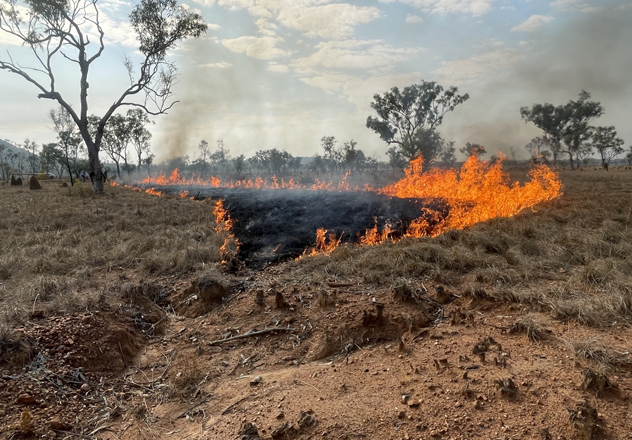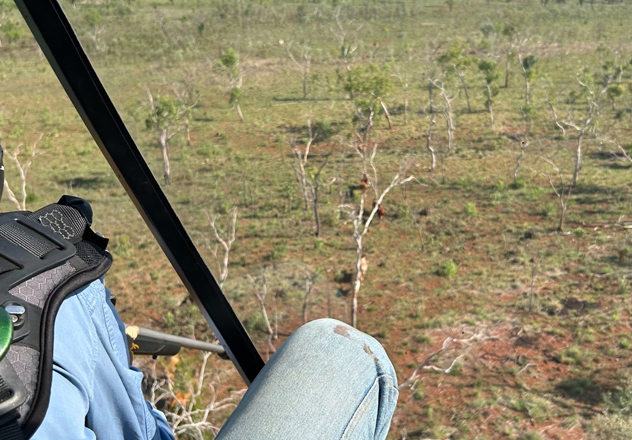As Australian Wildlife Conservancy (AWC) ushers in the New Year, the team at Yampi Sound Training Area (YSTA) reflect on the challenges and triumphs of the last few months. From battling wildfires to strategic feral control and comprehensive surveys, the journey has been both arduous and enlightening, providing insights which will shape future conservation efforts.
Fire
In the last few months, YSTA has experienced another significant late dry season wildfire barrage – particularly throughout the lowlands.
AWC has worked on the Department of Defence property at Yampi alongside Dambimangari Aboriginal Corporation (DAC) rangers since 2016, and in that time, our team says, there have been few wildfire seasons as threatening as this one. In total, between September and December 2023, Yampi experienced 10 separate wildfire ignitions, with a total burn percentage of over 75% of the landscape.
With unseasonal rain earlier in the year leading to regrowth of fuel on previously fire-managed areas and no relief from rainfall until early December, the team experienced extremely hot fire behaviour and rapid rates of spread, rather unlike what has been observed previously on Yampi.
While this represents an extremely challenging season, there have also been some positive takeaways. The team remained level-headed across 14 days battling fires, working hard to maximise the protection of ecosystems within and beyond Yampi’s gates. One of the team’s responses to a massive fire approaching from south of the training area included the use of controlled burns to stitch between gaps in areas which had received prescribed burns earlier that year. This and other targeted suppression efforts resulted in the protection of several Ecological Priority Zones.
 Alexander Neilson/AWC
Alexander Neilson/AWC
AWC Operations Manager Braden Riles says, “Learnings from 2023 will be pivotal going forward, both to break a currently observed grass-fire cycle and continue managing fire with respect to an ever-changing climate.”
Ferals
While expansive and intense fires reduce cover and standing water availability for native species, the same is true for ferals, providing an opportunity for targeted aerial control. Yampi’s team have taken full advantage of these circumstances, removing two cats, 876 feral herbivores, and one hundred pigs over five days as part of a focused aerial shooting operation. This is the greatest number of pigs ever removed from Yampi by AWC in a single operation. The team found significantly less feral herbivores in areas of previous aerial shooting, reflecting the value of these operations in improving conditions for native species.
 D Horsford/AWC
D Horsford/AWC
Having completed their work at Yampi, the team continued aerial feral control on neighbouring AWC properties, ending the operation with a total of 2,116 feral animals removed from a connected landscape spanning almost 10,000 square kilometres. In addition to this, DAC rangers and AWC land managers also engaged in multiple nights of targeted cat management, using thermal technology to detect and destroy cats across the YSTA lowlands.
The team also took time to share key learnings and strategies for feral management with DAC rangers. These workshops involved expert guidance in the safe and humane use of firearms and the targeted management of invasive species. Other learning opportunities included a Conservation Leadership Course in Zimbabwe, which enriched team members’ skills in managing complex programs and multidisciplinary teams in priority conservation areas. Teaching and learning opportunities such as these ensure the swathes of knowledge accumulated within conservation organisations are effectively disseminated across teams, facilitating effective and science-informed conservation programs.
Surveys and weeds
 Naomi Blondel/AWC
Naomi Blondel/AWC
Ever the overachievers, our team didn’t let an involved training, fire and feral management program impede their weed management efforts. Despite the extreme effects of the fires, they completed a successful weeding program before the end of the year, eradicating small infestations and setting the stage for continued efforts against invasive species.
Collaboratively, AWC and DAC staff undertook 42 wetland assessments on Yampi’s lowland regions. Due to the sensitivity of wetlands to climatic changes, fire, cattle and pigs, monitoring over time is imperative to assessing management outcomes and ensuring the long-term health of these sensitive habitats. The team observed a notable reduction in the impact from pigs and cattle, providing direct evidence of the positive outcomes resulting from current management initiatives.
An additional positive outcome from the trip was the upskilling of DAC rangers in weed identification, facilitated by AWC land management officers using Yampi’s weed management plan. These teachings enabled them to assess wetlands independently, diversifying their skill sets and enhancing the efficiency of the study.
Other highlights of our weed management work include the inaugural use of slow drive surveys to assess the extent of priority weeds that get carried around properties by vectors such as vehicles and grading machinery, and the removal of two mission grass infestations on the property. The coming years will see the team treating the seedbank, working towards eventual complete eradications of this species on Yampi.
AWC thanks our staff and partners on the ground; their consistent integration of fire management, feral control, and surveys in the face of great environmental threats is testament to their adaptability and expertise. As we chart the course ahead, this year’s learnings will steer our strategies, supporting the continued preservation of Yampi’s distinctive ecosystems.
Support AWC's work at Yampi Sound training Area
Donate now